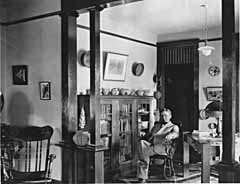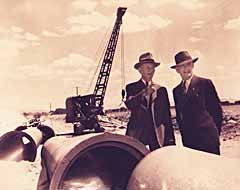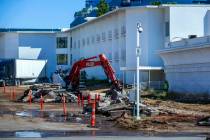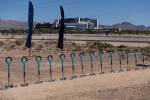Walter Bracken
In the 1940s, a few Las Vegans used to brag that they saw the 1905 land auction, when downtown lots sold for an average of $452, and the best hotel was made of canvas. Arriving on a train for the auction was the Western equivalent of having an ancestor on the Mayflower.
Walter Bracken, however, was here to meet the train.
And from its very beginnings as a town, until his death in 1950, Las Vegas' story and Bracken's were intertwined. Agent for the railroad that decreed a town would be, and for the land and water company that directed its growth, Bracken was seen in his time as a local Pilate to the railroad Caesars. Thought to have unlimited power over local affairs, he in fact toiled much of his career under micromanaging bosses. Yet he managed to steer Las Vegas in directions he thought best.
Born in 1870 in Mount Pleasant, Ohio, Bracken became a civil engineer. He first saw Las Vegas in 1901, from a horse-drawn buckboard, as part of a team picking a route for the San Pedro, Los Angeles & Salt Lake Railroad. The survey party recommended railroad planners buy Las Vegas Ranch, already a well-known rest stop, and the rights to its plentiful water. Its location and water meant it could be more than a "jerkwater town;" it was a logical choice for a substantial community where steam engines could be serviced, and where train crews and mechanics could be housed.
Bracken took possession of the old ranch and in 1904 became the postmaster. Bracken's post office was a tent in which he lived.
He was involved in surveying for a new townsite, and arranged to give free lots to any denomination that would agree to establish a church. He set aside the land on which a city library and even the Clark County Courthouse eventually were built even though Las Vegas was then part of Lincoln County, with a county seat in Pioche.
In the spring of 1905 the railroad began advertising the new townsite. Another developer named J.T. McWilliams began selling lots in his own townsite west of the tracks, contributing to the rush for land.
The railroad announced that its lots would be sold at auction only, and announced special passenger rates for those traveling to the auction ($16 from Los Angeles, $20 from Salt Lake City, to be rebated if the ticketholders actually purchased a lot). People also made their way to Las Vegas via covered wagon, buckboard, and horseback. On May 15, when an auctioneer opened bidding on the first lots, more than 1,000 people stood in the growing heat, hoping to claim a piece of the new town.
When the final gavel dropped 176 choice lots -- there were 1,200 available -- had been sold, and Bracken owned one.
As soon as the auction was over he caught a train for Salt Lake City, where two days later he married a schoolmarm named Anna Johnson. Anna was a Nevada native, born in Eureka and a graduate of the University of Nevada. She taught at Delamar, now a ghost town but then a booming mining community. Surveying work had brought Bracken to Delamar, and into the heart of Anna Johnson.
The couple honeymooned in San Francisco. On returning to Las Vegas, Anna was introduced with a big party at the ranch. An account topped a local newspaper: "Splendid reception at Ranch Resort," read the first headline deck. "Mr. & Mrs. Walter Bracken Entertain," said the second. "Lavish Banquet Enjoyed by Many Guests," said the third. "Charming Event Marks Home Coming After Pleasant Wedding Trip," said a fourth. The article said the dining hall was decorated with "trailing vines, ferns and willows gathered from the banks of the creek ..." Anna quickly adapted to their lifelong positions as leaders in the community's social-business elite. She was largely responsible for establishing the first local library.
The Brackens soon built a big gray stone home at 410 Fremont St., where they would live for 37 years before selling it for business development. In 1942 the couple moved to the home at 417 S. Seventh St., where they would spend the rest of their lives.
Bracken served as the railroad agent in Las Vegas but was more active as the agent of the Las Vegas Land & Water Company, the subsidiary set up by the railroad to develop its land holdings.
To most Las Vegans, that made him The Man, who seemed to run the town. But in the first 25 years of his long career Bracken was carrying out orders of his distant superiors.
The relationship was proven in 1989, when Bob Coffin, a Nevada state senator, rare book dealer and amateur historian, dug up a trove of documents from the railroad.
"They were in the basement of this building in Los Angeles ... Sometimes the fungus and mold was so bad I had to wear a mask," remembered Coffin.
Coffin saved more than 300,000 pages. He eventually sold the collection and index for $330,000 to his alma mater, UNLV. There, in the Special Collections section of the UNLV library, historians and students have only begun to interpret the content.
These documents make it clear the railroad thoroughly micromanaged its Las Vegas operations. "They had to account for every horseshoe nail," said Coffin.
One series of letters from about 1910 relates Bracken's efforts to buy an automobile for company use. J. Ross Clark, president of the company and vice president of the entire railroad, had his own chauffeur inspect the car, then told him not to buy it.
The subject of this painstaking attention was a used Ford.
A long exchange of letters about 1920 detailed Bracken's efforts to get better rental housing for railroad employees. New workers would be transported to Las Vegas, look at the housing available, and take the next train back for Los Angeles. Each time this happened Bracken sent a letter describing the incident, and each answer brought him a little closer to being authorized to remodel the rental housing.
Then somebody would rent the housing despite its shoddy condition, and plans would be dropped indefinitely.
Bracken was a voice for decency in the railroad's treatment of employees and citizens of the railroad town. In 1918, a train struck and killed a worker. Bracken urged the railroad to do right by the employee's survivors. A letter from him to the general manager in Los Angeles shows his frustration.
"I have just been served with papers as follows: A.W. Ham, administrator of the Estate of A.R. Nelson, Deceased, Plaintiff, vs. Los Angeles and Salt Lake Railroad Co., defendant ... They bring suit to recover the sum of $25,125 damages ...
"I herewith attach copy of my letter of Feb. 22 in reference to Gerald Nelson, the boy and sole heir, who you will remember interviewed you here in Las Vegas. It seems to me we were negligent in this case, for I am sure, a few hundred dollars would, at the right time, have settled the matter ...
"Now that the sharks have gotten hold of this boy, there is no way out, only to carry it thru court and just as sure sure as I am writing this letter, he will get a judgment against us."
Bracken directed the installation of the town's first water system, using pipes made of redwood staves, bound with metal hoops. Redwood pipes weren't as good as iron, but they were cheaper, and in the view of the San Pedro, Los Angeles & Salt Lake, that settled the choice.
The railroad interests were slow to pave the streets -- made it harder to dig up and maintain water mains. There was no significant city park or civic center until the New Deal, said Michael Green, a historian who teaches at Clark County Community College.
"They were also very slow to run water lines beyond the original town site," said Green. The idea, he explained, was to assure that growth stayed close to the railroad, where it was easy to serve. "But the real effect was that developers drilled their own wells. So eventually, you had 100 uncapped artesian wells in the valley, pouring out water constantly. Certainly that contributed to the dropping of the water table."
Though Bracken lacked authority, he buttoned his lip and accepted the blame.
Coffin said Bracken appeared to have been not so much a decision maker as "an important, reliable conduit of information from the leaders of the town to the railroad. He told them the truth. He didn't sugar coat it."
"I think he kept up the railroad's confidence in the town as something more than a place to water its engines. You find them making these grandiose plans for a model ranch, to be built on the site of the Las Vegas Ranch, where they would grow produce and supply the railroad with food. It would also be a tourist attraction. They were simultaneously developing Bryce Canyon, Zion, the North Rim of the Grand Canyon."
The ranch attraction was never developed, possibly because it was realized the pending construction of Boulder Dam would give the community the desired tourist attraction.
Coffin notes, "These guys could have been five times bigger than Howard Hughes if they'd wanted the real estate, but they chose to remain professional railroaders."
Coffin knew of an incident that said much about Bracken's relationship with the railroad:
"Once somebody in high management sent an investigator up here who went around town, talking to business people and employees, trying to find out what people thought of Bracken. When he returned, he wrote a lengthy memo which showed he was the ideal company man, and to have him on the ground was invaluable, and that he had contacts everywhere and little escaped his attention."
And when W.M. Jeffers became president of the Union Pacific in the 1930s, he decided to give Bracken the authority everybody thought he already had.
The late W.V. Wright, former general manager of the Review-Journal, knew him after he got it. "When I came here in 1941 Bracken was the voice of Union Pacific, and it seemed like anything that went on had to be OK'd by Union Pacific," he said.
"There was a strong organization at the time that was boosting Las Vegas, and where did they meet for lunch? They met in the Beanery, which was a sort of restaurant in the UP depot. It was a good place to eat, but there were plenty of others, and the fact they always met there says something about the relationship between the UP and the town."
Green says some of the UP's old-fashioned policies continued after Bracken had the power to change them. "You find restrictive covenants in deeds in the earlier years." He doubts Bracken set the policy, but he implemented it, and it confined black residents to Block 17, adjacent to Las Vegas' infamous red-light district, Block 16. In the 1940s, the city brought heavy-handed pressure on black businessmen downtown to remove themselves to West Las Vegas. "It isn't clear who is responsible, but they moved on his watch ... Certainly none of this makes Bracken unique; he reflected his times."
During Bracken's first few years here, Las Vegas was the jumping-off place for mining booms at Rhyolite and Goldfield. More than one town dweller made a fortune buying a piece of some "single-blanket, jackass prospector," who eventually struck it rich. Bracken tried it but had no luck. "Through the years I spent plenty of money grubstaking but have never gotten back a dollar," he told a local newsman in 1948.
The Brackens enjoyed a rich social life and Bracken was active in virtually all community organizations. But while his wife traveled fashionably in Europe, nobody remembers Bracken taking a vacation in a career that spanned more than 40 years. Failing eyesight forced his retirement in 1946.
On Jan. 2, 1950, after actively participating in the social events of Las Vegas' holiday season, the Brackens were sitting in their living room listening to the radio, when Anna Bracken remarked that she felt ill. Before a doctor could arrive, she died of a heart attack.
Already in failing health, Walter Bracken quickly grew worse without his mate of 45 years. He survived her by only seven months, dying on July 13, 1950.
Part I: The Early Years
Part II: Resort Rising
Part III: A City In Full






























